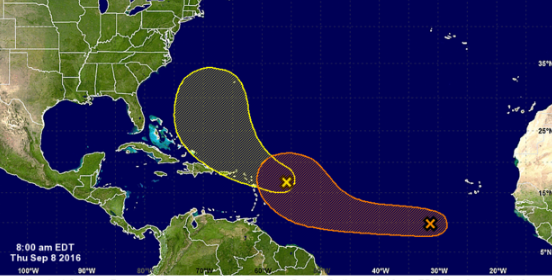Written by the TreasureGuide for the exclusive use of treasurebeachesreport.blogspot.com.
 |
| Two Atlantic Disturbances To Watch. |
As you can see there are now two systems that we need to watch, both of which seem to be headed to the east of the Treasure Coast.
The second (red) has a higher chance of becoming a cyclone in the next couple of days.
Both of these could bring us some north/northeast winds. There is no big increase in surf predicted yet. In fact the predictions are showing mostly a two-foot surf for the next few days.
---
You might think that deep sea wrecks rest undisturbed. That is not usually the case. Various types of fishing trawlers and things rake through wreck sites, scattering the remains and breaking artifacts.
Many pictures and examples are shown in an Odyssey Marine study.
 |
| One of Many Pictures Showing Effects of Deep Sea Fishing. |
http://www.shipwreck.net/pdf/OMEPapers4Final_000.pdf
---
In recent weeks I've talked about cobs found as a cache that were in remarkable condition. Many cobs found on a beach will be very much corroded and some will be so corroded that it is difficult or impossible to tell for sure what they are.
In the past I've found some cobs that were in very good or excellent condition on one side and very poor condition on the other side.
Below is a grading system used in one Odyssey Marine paper.
Grade One coins display little or no visible ocean wear, show little or no roughness or pitting, and, therefore, look much as they did when new. Both sides are in Very Good to Excellent condition and the obverse and reverse features resulting from the original strike are defined and easily identifiable.
Grade Two coins were partly exposed to the elements. The coin may not be completely intact or it may look more ‘sand-blasted’ than a Grade One, but the quality is still Good and most of the features resulting from the original strike are easily identifiable.
Grade Three coins are in Fair overall condition, but ocean wear is very apparent. Many Grade Three coins were typically located on the outer layer of a shipping chest and, therefore, the side of the coin that faced into the chest will be of Grade One or Grade Two quality. The opposite side, exposed to the elements following the wooden chest’s deterioration, is completely worn away. Other Grade Three coins might incorporate ocean wear distributed across both sides of the coin. On Grade Three coins, obverse and/or reverse sides will still offer easily identifiable characteristics that have definition.
Grade Four coins are still identifiable as Spanish Colonial coins, but they have been subject to much wear and tear and the markings are faint and have little or no definition.
Grade Five coins are just above a fragment in quality, but can still be identified as a coin taking into consideration factors such as shape and provenience. • A Fragment is a piece of silver recovered among concentrations of coins, but with no markings to identify it as a coin.
Here is the link for that source.
http://www.shipwreck.net/pdf/OMEPapers30-2013_001.pdf
They talk about one way that cobs end up being good on one side and poor on another side. They are referring to cobs that were salvaged from the sea and probably never spent any time on a beach.
One cob I'm reminded of was found on a beach and appeared to have been just washed out of the dunes. It had a sand and shell crust covering one side. That side was not visible at all because of the crust when it was dug. The other side was not covered and displayed fairly good detail.
When the sand/shell crust was removed, that side then showed remarkable detail - much better than the exposed side. The crust protected that surface of the cob, while the other side was worn down by washing around on the beach.
I'm not certain why one side was covered with a crust while the other side wasn't. I do believe that that cob spent many years in the dunes.
How a cob corrodes can depend upon what it is next to.or touches. I once did a couple of posts on surface analysis of cobs and talked about galvanic corrosion.
You can go to the following post to read about that.
http://treasurebeachesreport.blogspot.com/search?q=surface+analysis
---
Happy hunting,
TreasureGuide@comcast.net